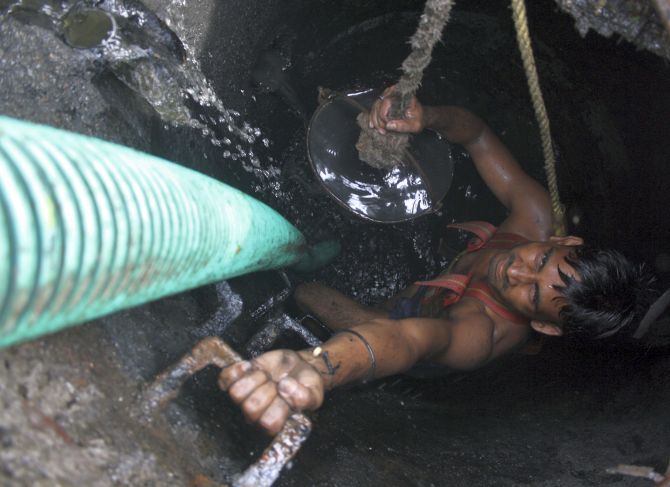It’s impossible to get the actual number of people dying and not getting compensation but the number is obviously much more than stingy official estimates. In any case, nowhere in the world are people sent inside gas chambers without oxygen cylinders and masks. Unofficial estimates suggest that on an average, one sanitation worker dies every five days all over the country, writes Shyamal Majumdar.
IMAGE: Unofficial estimates suggest that on an average, one sanitation worker dies every five days all over the country. Photograph: Parivartan Sharma/Reuters
Trust political parties to promise the moon to voters during election time. Just two days after a 24-year-old sanitation worker died while cleaning a deep sewer in North East Delhi, the Aam Aadmi Party’s election manifesto promised financial assistance of Rs 1 crore to the families of sanitation workers who die while performing their duties.
The AAP leadership perhaps doesn’t know that just about half of the number of the workers who have died cleaning sewers in the country have received the Supreme Court-mandated compensation of Rs 10 lakh. Before promising Rs 1 crore, why not make sure that all pending compensation of Rs 10 lakh is paid immediately to the families of workers who died in Delhi?
The central government hasn’t done any better. Budget 2020-21 has set aside the same amount allocated last year for rehabilitating manual scavengers, although 2019 recorded the highest number of fatalities among sewerage workers in recent years, prompting experts to question if the government was serious about addressing the scourge.
It’s impossible to get the actual number of people dying and not getting compensation but the number is obviously much more than stingy official estimates. In any case, nowhere in the world are people sent inside gas chambers without oxygen cylinders and masks. Unofficial estimates suggest that on an average, one sanitation worker dies every five days all over the country.
For example, one of Mumbai’s civic authorities directly employs around 30,000 people to keep the city clean, but the more difficult and dangerous job of unblocking sewer lines is usually done by casual workers who scoop out sludge with bare hands and are hired on a day-to-day basis through contractors. So they are not eligible for medical and life insurance benefits and hardly anybody keeps track of compensation in case of deaths.
It is inconceivable how even the country’s top two metropolitan cities have little to show in terms of scientific sewerage and sewage disposal systems and their regular maintenance. Sewage disposal is in effect left to abjectly poor individuals exploited by contractors, with no official monitoring or regulation.
People’s Union for Democratic Rights did a study last year on deaths of sewer/septic tank workers in the national capital. The report, which details the findings of investigations into six incidents of deaths of sanitation workers, draws attention to the lack of provision in urban planning for maintenance of sewerage systems; the lack of provision of safety gear and safety equipment or training for sewer/septic tank cleaners; and the lack of criminal prosecution of those guilty of sending them to do this hazardous work manually.
The biggest drawback of the Prohibition of Employment as Manual Scavengers and their Rehabilitation Act, passed in 2013, is this: while it defines cleaning of the sewers as hazardous only when done without safety gear and without safety precautions, it does not define what necessary measures would count as “safety precautions” and what “safety gear” is. Besides, it allows for manual cleaning of sewers if these requirements are met oblivious of the fact that in most cases the reason for death happens to be asphyxiation due to exposure to poisonous gases which cannot be helped with precautions.
The PUDR report also quotes a study conducted by the Sanitation Workers Project which says there are almost five million workers in the country employed to perform these tasks. The main reason for deaths in the process of sewage cleaning is the depletion of oxygen and presence of toxic gases, mostly hydrogen sulphide.
It is also widely known that most sewage cleaners suffer from tuberculosis.
This explains why many sewer workers die as young as 40, falling prey to multiple health issues. Repeated handling of human excreta without any safety equipment leads to several respiratory and skin diseases, anaemia, jaundice, trachoma and carbon monoxide poisoning. This affects women more as up to 90 per cent of sanitation workers are women. Households with dry latrines prefer women to clean excreta instead of men as they are located inside the house. There is also a huge gap in the wages of men and women workers.
A year ago, Prime Minister Narendra Modi washed the feet of safai karamcharis at Prayagraj and hailed them as “karma yogis”. It will be better if he can at least ensure that the families of the karma yogis who die on duty get the compensation due to them.




